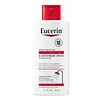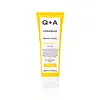What's inside
What's inside
 Key Ingredients
Key Ingredients

 Benefits
Benefits

 Concerns
Concerns

 Ingredients Side-by-side
Ingredients Side-by-side

Colloidal Oatmeal 2%
AbsorbentWater
Skin ConditioningIsopropyl Palmitate
EmollientGlycerin
HumectantCetearyl Alcohol
EmollientSodium Cocoamphoacetate
CleansingCaprylic/Capric Triglyceride
MaskingOctyldodecanol
EmollientC12-15 Alkyl Benzoate
AntimicrobialSodium Myreth Sulfate
CleansingCetearyl Isononanoate
EmollientXanthan Gum
EmulsifyingCeramide NP
Skin ConditioningAlanine
MaskingArginine Hcl
Skin ConditioningCarnitine
CleansingGlycine
BufferingSodium PCA
HumectantLauryl Glucoside
CleansingCitric Acid
BufferingSodium Chloride
MaskingPhenoxyethanol
PreservativeCarbomer
Emulsion StabilisingSodium Hydroxide
BufferingPentylene Glycol
Skin ConditioningDecylene Glycol
Skin ConditioningSodium Benzoate
MaskingColloidal Oatmeal 2%, Water, Isopropyl Palmitate, Glycerin, Cetearyl Alcohol, Sodium Cocoamphoacetate, Caprylic/Capric Triglyceride, Octyldodecanol, C12-15 Alkyl Benzoate, Sodium Myreth Sulfate, Cetearyl Isononanoate, Xanthan Gum, Ceramide NP, Alanine, Arginine Hcl, Carnitine, Glycine, Sodium PCA, Lauryl Glucoside, Citric Acid, Sodium Chloride, Phenoxyethanol, Carbomer, Sodium Hydroxide, Pentylene Glycol, Decylene Glycol, Sodium Benzoate
Water
Skin ConditioningCetearyl Alcohol
EmollientSodium Cocoyl Isethionate
CleansingPrunus Amygdalus Dulcis Oil
Skin ConditioningGlycerin
HumectantXanthan Gum
EmulsifyingCeramide NP
Skin ConditioningSqualane
EmollientAnanas Sativus Fruit Extract
Skin ConditioningSimmondsia Chinensis Seed Oil
EmollientOlive Glycerides
EmulsifyingGlucose
HumectantXylitylglucoside
HumectantAnhydroxylitol
HumectantXylitol
HumectantSodium Stearoyl Glutamate
CleansingSodium Benzoate
MaskingSodium Gluconate
Skin ConditioningCaprylyl Glycol
EmollientPolyacrylate Crosspolymer-6
Emulsion StabilisingCyclodextrin
AbsorbentParfum
MaskingPhenoxyethanol
PreservativeSodium Hydroxide
BufferingHexyl Cinnamal
PerfumingLinalool
PerfumingBenzyl Salicylate
PerfumingWater, Cetearyl Alcohol, Sodium Cocoyl Isethionate, Prunus Amygdalus Dulcis Oil, Glycerin, Xanthan Gum, Ceramide NP, Squalane, Ananas Sativus Fruit Extract, Simmondsia Chinensis Seed Oil, Olive Glycerides, Glucose, Xylitylglucoside, Anhydroxylitol, Xylitol, Sodium Stearoyl Glutamate, Sodium Benzoate, Sodium Gluconate, Caprylyl Glycol, Polyacrylate Crosspolymer-6, Cyclodextrin, Parfum, Phenoxyethanol, Sodium Hydroxide, Hexyl Cinnamal, Linalool, Benzyl Salicylate
 Reviews
Reviews

Ingredients Explained
These ingredients are found in both products.
Ingredients higher up in an ingredient list are typically present in a larger amount.
Ceramide NP is a type of ceramide and formally known as ceramide 3.
Ceramides are intercellular lipids naturally found in our skin that bonds dead skin cells together to create a barrier. They are known for their ability to hold water and thus are a great ingredient for dry skin.
Ceramides are an important building block for our skin barrier. A stronger barrier helps the skin look more firm and hydrated. By bolstering the skin ceramides act as a barrier against irritating ingredients. This can help with inflammation as well.
If you would like to eat ceramides, sweet potatoes contain a small amount.
Read more about other common types of ceramides here:
Ceramide AP
Ceramide EOP
Cetearyl alcohol is a mixture of two fatty alcohols: cetyl alcohol and stearyl alcohol. It is mainly used as an emulsifier. Emulsifiers help prevent the separation of oils and products. Due to its composition, it can also be used to thicken a product or help create foam.
Cetearyl alcohol is an emollient. Emollients help soothe and hydrate the skin by trapping moisture.
Studies show Cetearyl alcohol is non-toxic and non-irritating. The FDA allows products labeled "alcohol-free" to have fatty alcohols.
This ingredient is usually derived from plant oils such as palm, vegetable, or coconut oils. There is debate on whether this ingredient will cause acne.
Due to the fatty acid base, this ingredient may not be Malassezia folliculitis safe.
Learn more about Cetearyl AlcoholGlycerin is already naturally found in your skin. It helps moisturize and protect your skin.
A study from 2016 found glycerin to be more effective as a humectant than AHAs and hyaluronic acid.
As a humectant, it helps the skin stay hydrated by pulling moisture to your skin. The low molecular weight of glycerin allows it to pull moisture into the deeper layers of your skin.
Hydrated skin improves your skin barrier; Your skin barrier helps protect against irritants and bacteria.
Glycerin has also been found to have antimicrobial and antiviral properties. Due to these properties, glycerin is often used in wound and burn treatments.
In cosmetics, glycerin is usually derived from plants such as soybean or palm. However, it can also be sourced from animals, such as tallow or animal fat.
This ingredient is organic, colorless, odorless, and non-toxic.
Glycerin is the name for this ingredient in American English. British English uses Glycerol/Glycerine.
Learn more about GlycerinPhenoxyethanol is a preservative that has germicide, antimicrobial, and aromatic properties. Studies show that phenoxyethanol can prevent microbial growth. By itself, it has a scent that is similar to that of a rose.
It's often used in formulations along with Caprylyl Glycol to preserve the shelf life of products.
Sodium Benzoate is a preservative. It's used in both cosmetic and food products to inhibit the growth of mold and bacteria. It is typically produced synthetically.
Both the US FDA and EU Health Committee have approved the use of sodium benzoate. In the US, levels of 0.1% (of the total product) are allowed.
Sodium benzoate works as a preservative by inhibiting the growth of bacteria inside of cells. It prevents the cell from fermenting a type of sugar using an enzyme called phosphofructokinase.
It is the salt of benzoic acid. Foods containing sodium benzoate include soda, salad dressings, condiments, fruit juices, wines, and snack foods.
Studies for using ascorbic acid and sodium benzoate in cosmetics are lacking, especially in skincare routines with multiple steps.
We always recommend speaking with a professional, such as a dermatologist, if you have any concerns.
Learn more about Sodium BenzoateSodium Hydroxide is also known as lye or caustic soda. It is used to adjust the pH of products; many ingredients require a specific pH to be effective.
In small amounts, sodium hydroxide is considered safe to use. However, large amounts may cause chemical burns due to its high alkaline.
Your skin has a natural pH and acid mantle. This acid mantle helps prevent harmful bacteria from breaking through. The acid mantle also helps keep your skin hydrated.
"Alkaline" refers to a high pH level. A low pH level would be considered acidic.
Learn more about Sodium HydroxideWater. It's the most common cosmetic ingredient of all. You'll usually see it at the top of ingredient lists, meaning that it makes up the largest part of the product.
So why is it so popular? Water most often acts as a solvent - this means that it helps dissolve other ingredients into the formulation.
You'll also recognize water as that liquid we all need to stay alive. If you see this, drink a glass of water. Stay hydrated!
Learn more about WaterXanthan gum is used as a stabilizer and thickener within cosmetic products. It helps give products a sticky, thick feeling - preventing them from being too runny.
On the technical side of things, xanthan gum is a polysaccharide - a combination consisting of multiple sugar molecules bonded together.
Xanthan gum is a pretty common and great ingredient. It is a natural, non-toxic, non-irritating ingredient that is also commonly used in food products.
Learn more about Xanthan Gum